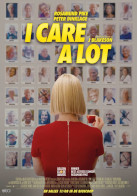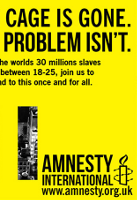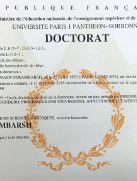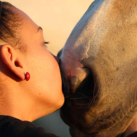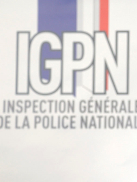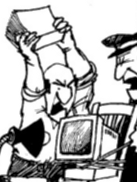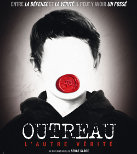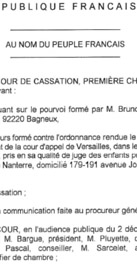| « « Cheval pour tous », quelle leçon pour la profession ? | A Taverny : voisins, services sociaux, justice, tout le monde savait » |
Fingers pointed in all directions over Katelynn Sampson case
Fingers pointed in all directions over Katelynn Sampson case
National Post, August 08, 2008
As more details emerge about how a seven-year-old girl came to be legally in the care of a couple now charged with her murder, it increasingly seems that Katelynn Sampson slipped through every crack in the system.
... The director of Aboriginal Legal Services of Toronto, which assisted at two court hearings where Katelynn’s care was formalized, said the organization’s role is to provide information on family cases not assess the fitness of guardians.
Mort de Katelynn Sampson
Une plainte contre la juge
radio-canada.ca, lundi 18 août 2008
Le Nouveau Parti démocratique de l'Ontario dépose une plainte contre la juge Debra Paulseth, qui a accordé la garde de la petite Katelynn Sampson à une femme qui avait des antécédents judiciaires de violence.
Le député néo-démocrate Peter Kormos demande au Conseil de la magistrature de l'Ontario d'enquêter. Selon lui, la juge Paulseth a omis de demander une vérification des antécédents de la mère adoptive.
Lundi, des Torontois ont manifesté devant un tribunal provincial pour protester contre la latitude laissée aux juges qui prennent des décisions concernant la garde des enfants.
La fillette a été trouvée morte il y a deux semaines, le corps couvert d'ecchymoses. La femme qui en avait la garde, Donna Irving, et son conjoint Warren Johnson sont maintenant accusés du meurtre de la fillette de 7 ans.
Le samedi 09 août 2008, www.cyberpresse.ca
Katelynn Sampson : les services sociaux disent n'avoir rien à se reprocher
Les services sociaux de l'Ontario affirment n'avoir joué aucun rôle dans le placement de Katelynn Sampson dans la famille de Donna Irving, où la fillette de 7 ans a finalement trouvé la mort. La mère biologique a elle-même cédé la garde légale de sa fille à Mme Irving sans que personne ne pose la moindre question sur les dossiers criminels de la tutrice et de son conjoint.
«La mort de cette enfant montre la nécessité d'examiner et d'évaluer soigneusement les circonstances du placement d'enfants qui se déroulent hors du système de protection de l'enfance. Les antécédents judiciaires des tuteurs devraient obligatoirement être examinés, comme les sociétés de protection de l'enfance en ont l'obligation légale.» Les Native Child and Family Services sont une division de la Direction de la protection de la jeunesse ontarienne. Ils ont pour mandat de veiller sur les enfants autochtones de la région de Toronto. Les deux autres enfants de Donna Irving sont désormais sous la garde des NCFS.
La juge approuve sans examen
Des transcriptions d'audiences du Tribunal de la jeunesse de l'Ontario, publiées hier dans le Toronto Star, montrent que la juge Debra Paulseth, qui a approuvé «l'entente privée» conclue entre Donna Irving et Bernice Sampson, n'a pas non plus posé la moindre question sur les antécédents judiciaires du couple formé par Donna Irving et Warren Johnson.
La mère biologique était toxicomane. Ses autres enfants avaient aussi été placés par les services de protection de l'enfance de l'Ontario. Bernice Sampson voulait placer sa fille chez Donna Irving, son amie depuis 10 ans.
La juge Paulseth, qui siège depuis 13 ans au Tribunal de la jeunesse, est arrivée à la première audience, le 19 février, en avouant qu'elle n'avait pas pris connaissance du dossier de Katelynn Sampson. «Pourquoi avez-vous choisi cette femme pour devenir la tutrice de votre enfant?» a-t-elle simplement demandé à Bernice Sampson. «C'est une amie, c'est ma meilleure amie», a répondu la mère. «Vous approuvez le choix de son conjoint?» a poursuivi la juge. «Oui», a répondu Mme Sampson.
Durant les trois audiences sur le cas de la fillette, le nom de Katelynn n'a été mentionné que sept fois. La juge Paulseth n'a posé aucune question sur les dossiers criminels de Mme Irving et M. Johnson, qui ont pourtant été condamnés pour possession et trafic de drogue, prostitution et voies de fait. La juge a en revanche fait faire des recherches pour retrouver le père biologique de la fillette, recherches qui se sont avérées infructueuses.
La juge a finalement accordé la garde légale de Katelynn Sampson à Donna Irving. Dimanche dernier, la fillette a été trouvée morte dans l'appartement du couple Irving-Johnson, le corps couvert de contusions. Donna Irving avait prétendu, en appelant les ambulanciers, que l'enfant s'était étouffée avec de la nourriture. Cette version a rapidement été contredite par la police.
La femme a été accusée, mardi, de meurtre non prémédité. Jeudi, son conjoint a fait face aux mêmes accusations.
ONTARIO (RC) - Plus de 200 personnes ont assisté, mardi après-midi, au service funèbre de la petite Katelynn Sampson dans une église presbytérienne de Toronto, dans l'est de la ville.
C'est avec douleur que sa mère, Bernice Sampson, est entrée aux côtés du cercueil de sa fille. Dans son homélie, le révérend a déclaré qu'il fallait mettre un frein à la violence dans la métropole.
Le corps de l'enfant de 7 ans a été retrouvé dans un appartement le 3 août dernier, alors qu'elle était sous la garde de sa tutrice légale. Selon la police, la fillette a été sauvagement battue.
La tutrice, Donna Irving, et son conjoint, Warren Johnson, font face à des accusations de meurtre non prémédité. La femme avait déjà des antécédents judiciaires.
No one spoke for Katelynn
Children have the right to be represented in decisions that affect them, advocates argue
TheStar, Aug 09, 2008, excerpt
Where was Katelynn Sampson's voice when a family court judge gave full custody of the 7-year-old girl to a woman who is now accused in her murder?
That's the question child advocates are asking in the wake of court transcripts detailing how Katelynn's biological mother, Bernice Sampson, 45, transferred custody of her daughter to neighbourhood friend Donna Irving, 29.
Irving and her partner Warren Johnson, 46, have been charged with second-degree murder in her death.
Katelynn's name is mentioned just seven times in transcripts of three custody hearings over five months this year, according to the court documents obtained by the Star Thursday.
Katelynn didn't appear in court. And nowhere in the 17 pages of transcripts are Katelynn's wishes or views expressed.
"Where was Katelynn in all of this? Just what was she thinking? How was she feeling?" asked Ontario Child Advocate Irwin Elman.
"Children are not property. They are human beings. A child has a right to be represented," said Martha Mackinnon, head of Justice for Children and Youth, a legal aid clinic that advocates for the rights of children in the justice, education and health care systems.
Court transcript outlines Katelynn's handover
Judge was focused on finding absent dad and didn't query guardian accused of killing 7-year-old Katelynn Sampson
TheStar, Aug 08, 2008
Joanna Smith, Staff Reporter
They mentioned her name seven times.
In court transcripts of three custody hearings held over five months this year to determine who would raise Katelynn Sampson, the seven-year-old found dead Sunday morning seemed to play a small part.
The hearings before Ontario Court Justice Debra Paulseth involved Katelynn's biological mother Bernice Sampson, the guardian now charged with her death, Donna Irving, and native family court worker Bela McPherson.
Sparse and businesslike, the conversations were dominated by the legal requirement of determining Katelynn's biological father and the need to move proceedings along.
Few questions were asked about Irving. No questions were asked about her past.
Irving was granted full custody of Katelynn on June 6. Two months later she died while in Irving's care. Irving called 911, claiming the child had stopped breathing while choking on food. Irving, 29, and her partner Warren Johnson, 46, have been charged with second-degree murder.
Paulseth began the first hearing, on Feb. 19, by saying she had not read the paperwork involved in bringing Irving and Sampson, 45, to court.
"Oh, okay, so, I haven't read this matter," Paulseth said. "That's all right."
"Why did you choose this gal to take care of your child?" she asked Sampson.
"She's my friend," Sampson replied.
"She's your friend," the judge said.
"Yes, she's my best friend," Sampson said.
Then Paulseth asked about Irving's partner. "You approve of her partner?" Paulseth asked.
"Oh, yes, no problems. Yes, I do, sorry," Sampson said.
Paulseth never asked Johnson's name.
It is not clear if Paulseth knew Irving had a criminal record including drugs, prostitution and violence, but she did not ask about it.
She would have known what Irving wrote on her application for custody: Sampson was a drug addict who could not manage her addiction and whose other children have been involved in the child welfare system.
Paulseth did not respond to a request for comment last night.
Paulseth asked Irving whether she had other children.
"Yes," Irving said.
"Tell me about them," Paulseth said.
"I have two boys, three and two," Irving said. Irving has two older children who do not live with her, but she did not mention them.
Paulseth was concerned Katelynn's biological father was not involved in the hearings. Irving had said the father was Mark Letang, of address unknown, while Sampson said the father was George States of Nova Scotia.
"I wish for him not to be a part of Katelynn's life," Sampson told the judge.
"Write up a piece of paper that just explains that to me," the judge instructed later on.
Paulseth said Irving would decide when Sampson could visit her daughter.
"Because your No. 1 concern is not your friend ..." Paulseth began to say.
"It's my – no, Katelynn," Sampson cut in.
"... it is going to be your daughter, right?" Paulseth said.
"Yes," Sampson said.
Sampson never returned to court.
At a hearing on May 14, only Paulseth and social worker McPherson attended and discussed the missing father, and how trying to find him was slowing things down.
"My sense was she just wants to get this sort of straightened up, you know," Paulseth said to McPherson about Irving. McPherson could not be reached for comment yesterday.
On June 6, the final hearing, Paulseth said she remembered the case; said she knew it was important to move things along.
McPherson agreed.
"She is now having quite extensive difficulties in her school with her learning, there's possibly learning disabilities, there's possibly behavioural issues and in order to access –she's already tried to access the services through the school for counselling for this little girl and they won't allow her too [sic] because she is not the custodial parent," McPherson told the judge.
By this time Katelynn had been absent from Grade 2 at Parkdale Public School for more than a month, a school board source has said.
The judge said Sampson not being in court was a problem because she wanted to know what to do about the missing father.
"She will not come back to court," McPherson said. "She thought that was all she needed to do was to come and say that she was fine with it and she feels like she's done her part, I guess, I'm assuming."
They moved on.
"And we need to kind of just have this over now, but if we had no further information and we just need to get this girl settled," said Paulseth, who practised in family court for 13 years and was assistant deputy attorney general for Court Services. "So I am just going to make a final custody order."
Then it came time to decide how much access Sampson should be given to her daughter.
"When mom wanted to come and see the child she was welcome to come and see her," McPherson explained was the gist of their verbal agreement.
Paulseth decided that it should be up to Irving to decide when Sampson could see her daughter.
"I mean you are taking on all the responsibility and we are never going to be exactly sure what kind of shape mom is in ..." the judge said.
"Yeah," said Irving.
"... and you do not need the further strife of having to, kind of, negotiate everything. So I am just going to make it in your discretion," Paulseth said. "Of course, it is going to be exercised in this little girl's best interest. That's all we can do, I think."
The Crisis Of Foster Care
TIME, in partnership wih CNN, US section
Monday, May. 29, 2006, 1/7, excerpt
The autopsy photo shows a little boy who looks relieved to be dead. His eyes are closed. A hospital tube protrudes from his broken nose. He has deep cuts above his right ear and dark linear scars on his forehead. The bruises on his back are a succession of yellows, greens and blues. On the bottom of his tiny feet are unhealed third-degree burns. He had been battered and tortured. He had been tied with panty hose and belts to a banister by the woman who had become his foster grandmother. The state of Georgia had taken him away from his mother, then abandoned him in the woman's care.
6/7, excerpt
"A brutal indifference has spread itself through the system," says Andrew Bridge, a former foster child in Los Angeles who went to Harvard Law School and now heads the Alliance for Children's Rights. He chaired a countywide panel that reviewed the state's foster-care record. Last January it concluded that the system in Los Angeles County operates with minimal data on its wards and a safety-monitoring process that is random at best. Some departments are not aware of what others are doing, so a child's safety often relies on guesswork. "Fundamentally," says Bridge, 34, "we've come a very small distance from the days when I was in foster care." In short, he adds, Los Angeles County lacks the ability to know the full nature of the quality of care foster children actually receive, "the full extent of harm children may face in foster care and how to protect children from harm in the future."
Victorian foster care system on verge of collapse
The World Today Archive - Friday, 20 October , 2000, excerpt
COMPERE: Child protection is one of the big issues for Australia, and nowhere more so today than in the state of Victoria where it's being said that the child protection system is on the verge of collapse.
This assertion is based on information in a hitherto secret report kept under wraps by the previous Kennett Government before it was voted from office one year ago.
The five year old Placement Changes Project was revealed, and it said 'the extent of foster care is in real crisis'. Finding that about a quarter of children in care in Victoria are constantly being shuffled between different foster homes, sometimes up to 10 times in just a couple of years.
The Community Services Minister, Christine Campbell, says she was unaware of the existence of the report until now. And certainly no one from her department informed the Labor Party when it came into government.
Welfare groups say they've been raising the issues contained in the report since its completion four years ago, even though it was never revealed publicly. Rebecca Barrett reports.
REBECCA BARRETT: Colleen Clare [phonetic] is the chief executive officer of the Children's Welfare Association of Victoria. She says work on the placement changes project started at the end of 1995 when the Association was asked to work on the report.
When the report was finished in 1996 she says the association did its own follow up work which confirmed the report's findings.
Foster care system to be investigated
July 25, 2004, www.theage.com.au, excerpt
Victoria's Auditor-General will investigate the state's foster care system, amid concerns over a serious shortage of carers, reports that placement agencies lack accountability and the growing number of children with highly complex needs.
The investigation will also look at the conditions of children living in state-funded residential units. The Sunday Age recently reported that a 15-year-old became addicted to heroin while living in a residential unit and welfare workers say chroming is widespread.
The 8600 children who live in residential units and foster homes are among the most physically, emotionally and sexually abused children in the state. Victoria has the highest rate of indigenous children in state care in Australia.
